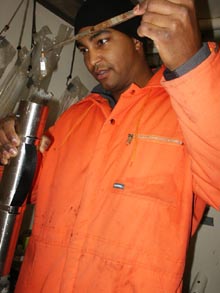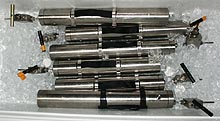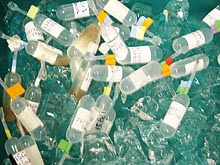
Dave Allen of the University of Washington examines microbiological samples collected during the Arctic expedition. A water sample that appears cloudy or foggy is indicative of a successful microbiological culture. Click image for larger view.

These housings were necessary to properly select and culture only microbes that can live in high-pressure environments. Click image for larger view.
Highlights of Novel Microbes in an Icy World
August 14 - September 8, 2002
David Allen
University of Washington, School of Oceanography
Our team of microbiologists was an international group including U.S., Canadian and Chinese representatives. Our primary responsibility was to search for novel microorganisms in the ice, the deep sea, and the benthic environment. Additionally, we collected a variety of samples for standard microbial analyses as well as genetic analyses that will help describe the microbial community of the deep Canada Basin. When planning for the cruise, we chose to combine standard microbiological techniques and new molecular genetic techniques with novel isolation and culturing methods to collect and study organisms that have not previously been described. We expect that the organisms we have isolated are adapted to cold (psychrophiles, cold-loving), salty (halophiles, salt-loving), and high-pressure (barophiles, pressure- loving) environments, because of the experimental methods that we employed both on the cruise and thereafter.
On the cruise, we obtained a great variety of samples for use in our culturing effort. The success of these collections depended upon constant communication with the various teams on the ship about what samples we were interested in having and how they needed to be collected in order to be useful to us. Samples associated with the sea ice and the deep sea were successfully collected and processed. On the cruise, care was taken to maintain a constant low temperature environment for the samples. Additionally, with the equipment and supplies we had on board, we were able to recreate the salinity of sea ice brines and the high hydrostatic pressures of the deep-sea samples to ensure a hospitable environment to the organisms we hope to isolate.
These colorful vials contain the microbiological samples collected during the Arctic cruise. Just one may contain a host of novel microbes specially adapted to survive in high-pressure, highly saline, or low-temperature environments. Click image for larger view.
A large number of water samples were processed on the cruise to allow us to describe the microbial community of the deep Canada Basin. Our collaborator from China, Dr. Chen Bo, will carry out most of this work. These samples will provide information about the types of bacteria and archaea that inhabit different portions of the Canada Basin and a community context for any organisms we are able to culture. We hope that after a careful look at the types of microorganisms that inhabit this region, we will be able to understand more about the environment itself.
After a great deal of preparation, the samples were successfully transported back to our laboratory in Seattle. Since their return, the samples have been cataloged and placed in appropriate areas for further incubation and processing. For many of the samples, this means that they were placed into a low-temperature incubator and maintained at hydrostatic pressures equivalent to seawater depths of 3,000 to 3,400 m to allow for further growth. Many of the samples have already shown growth by turbidity (by visible cloudiness of the sample containers), indicating that we have successfully isolated organisms from the Canada Basin. This is only a first step in the long process of isolating individual species.As we proceed with the analyses, further collaboration with many of the investigators from the cruise will be both useful and necessary. We will certainly need to obtain the data that were generated during net tows, at sea ice stations, and at some of the box-core stations. Finally, we will anxiously await all of the pertinent data from the rosette casts to link our microbiological data with those of the water column.
Sign up for the Ocean Explorer E-mail Update List.


























